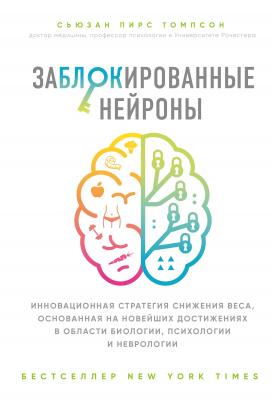Заблокированные нейроны. Сьюзан Пирс Томпсон
Читать онлайн.| Название | Заблокированные нейроны |
|---|---|
| Автор произведения | Сьюзан Пирс Томпсон |
| Жанр | Медицина |
| Серия | Открытия века: новейшие исследования человеческого организма во благо здоровья |
| Издательство | Медицина |
| Год выпуска | 2017 |
| isbn | 978-5-04-091448-7 |
13
Baumeister, R. F., Bratslavsky, E., Muraven, M., & Tice, D. M. (1998). Ego depletion: Is the active self a limited resource? Journal of Personality and Social Psychology, 74(5), 1252-1265. doi: 10.1037/0022-3514.74.5.1252
14
Vohs, K. D., Baumeister, R. F., Schmeichel, B. J., Twenge, J. M., Nelson, N. M., & Tice, D. M. (2008). Making choices impairs subsequent self-control: A limited-resource account of decision making, self-regulation, and active initiative. Journal of Personality and Social Psychology, 94(5), 883-898. doi: 10.1037/0022-3514.94.5.883
15
Danziger, S., Levav, J., Avnaim-Pesso, L., & Kahneman, D. (2011). Extraneous factors in judicial decisions. Proceedings of the National Academy of Sciences of the United States of America, 108(17), 6889-6892. doi: 10.1073/pnas.1018033108
16
Gailliot, M. T., Baumeister, R. F., DeWall, C. N., Maner, J. K., Plant, E. A., Tice, D. M…. Schmeichel, B. J. (2007). Self-control relies on glucose as a limited energy source: Willpower is more than a metaphor. Journal of Personality and Social Psychology, 92(2), 325-336. doi: 10.1037/0022-3514.92.2.325
17
Hofmann, W., Baumeister, R. F., Förster, G., & Vohs, K. D. (2012; 2011). Everyday temptations: An experience sampling study of desire, conflict, and self-control. Journal of Personality and Social Psychology, 102(6), 1318. doi: 10.1037/a0026545
18
Baumeister, R. F. (2014). Self-regulation, ego depletion, and inhibition. Neuropsychologia, 65, 313-319. doi: 10.1016/j.neuropsychologia.2014.08.0
19
Gailliot, M. T., & Baumeister, R. F. (2007). The physiology of willpower: Linking blood glucose to self-control. Personality and Social Psychology Review, 11(4), 303-327. doi: 10.1177/1088868307303030
20
McCullough, M. E., & Willoughby, B. L. B. (2009). Religion, self-regulation, and self-control: Associations, explanations and implications. Psychological Bulletin, 135(1), 69-93. doi: 10.1037/a0014213
21
Luders, E., Toga, A. W., Lepore, N., & Gaser, C. (2009). The underlying anatomical correlates of long-term meditation: Larger hippocampal and frontal volumes of gray matter. Neuroimage, 45(3), 672-678. doi: 10.1016/j.neuroimage.2008.12.061
22
McKellar, J., Stewart, E., & Humphreys, K. (2003). Alcoholics anonymous involvement and positive alcohol-related outcomes: Cause, consequence, or just a correlate? A prospective 2-year study of 2,319 alcohol-dependent men. Journal of Consulting and Clinical Psychology, 71(2), 302-308. doi: 10.1037/0022-006X.71.2.302
23
Greer, S., Goldstein, A., & Walker, M. (2013). The impact of sleep deprivation on food desire in the human brain. Nature Communications, 4, 2259 doi: 10.1038/ncomms3259
24
DeSteno, D., Li, Y., Dickens, L., & Lerner, J. S. (2014). Gratitude: A tool for reducing economic impatience. Psychological Science, 25(6), 1262-1267. doi: 10.1177/0956797614529979
25
Wansink, B., & Sobal, J. (2007). Mindless eating: The 200 daily food decisions we overlook. Environment and Behavior, 39(1), 106-123. doi: 10.1177/0013916506295573
26
Dulloo, A. G., & Jacquet, J. (1998). Adaptive reduction in basal metabolic rate in response to food deprivation in humans: A role for feedback signals from fat stores. The American Journal of Clinical Nutrition, 68(3), 599.
27
Speakman, J. R., & Westerterp, K. R. (2013). A mathematical model of weight loss under total starvation: Evidence against the thrifty-gene hypothesis. Disease Models & Mechanisms, 6(1), 236-251. doi: 10.1242/dmm.010009
28
Rosenkilde, M., Auerbach, P., Reichkendler, M. H., Ploug, T., Stallknecht, B. M., & Sjödin, A. (2012). Body fat loss and compensatory mechanisms in response to different doses of aerobic exercise – a randomized controlled trial in overweight sedentary males. American Journal of Physiology: Regulatory, Integrative and Comparative Physiology, 303(6), 571-579. doi: 10.1152/ajpregu.00141.2012
29
An fMRI shows differences between lean and obese after eating. Puzziferri, N., Zigman, J. M., Thomas, B. P., Mihalakos, P., Gallagher, R., Lutter, M…. Tamminga, C. A. (2016). Brain imaging demonstrates a reduced neural impact of eating in obesity. Obesity, 24(4), 829-836. doi: 10.1002/oby.21424
30
Satter, E. M. (2005), Your Child’s Weight: Helping Without Harming, Madison, WI: Kelsey Press.
31
Wansink, B., Painter, J., & North, J. (2005). Bottomless bowls: Why visual cues of portion size may influence intake. Obesity Research, 13(1), 93-100. doi:10.1038/oby.2005.12
32
Lisle, D. J. & Goldhamer, A. (2003) The Pleasure Trap. Summertown, TN: Healthy Living Publications.
33
Malaisse, W. J., Vanonderbergen, A., Louchami, K., Jijakli, H., & Malaisse-Lagae, F. (1998). Effects of artificial sweeteners on insulin release and cationic fluxes in rat pancreatic islets. Cellular Signalling, 10(10), 727-733. doi: 10.1016/S0898-6568(98)00017-5
34
Malaisse, W. J., Vanonderbergen, A., Louchami, K., Jijakli, H., & Malaisse-Lagae, F. (2011). Intake of high-intensity sweeteners alters the ability of sweet taste to signal caloric consequences: Implications for the learned control of energy and body weight regulation. The Quarterly Journal of Experimental Psychology, 64(7), 1430-1441. doi: 10.1080/17470218.2011.552729
35
Ingalls, A. M., Dickie, M. M., & Snell, G. D. (1996). Obese, a new mutation in the house mouse. Obesity Research, 4(1), 101-101. doi: 10.1002/j.1550-8528.1996.tb00519.x
36
Zhang, Y., Proenca, R., Maffei, M., Barone, M., Leopold, L., & Friedman, J. M. (December 1994). Positional cloning of the mouse obese gene and its human homologue. Nature, 372(6505), 425-432. doi: 10.1038/372425a0
37
Stavro, B. (1995, September 5). With fat-loss drug, Amgen takes on a weighty challenge: Pharmaceuticals: Biotech firm faces much risk and expense in getting the medication from the laboratory to the marketplace. Los Angeles Times. Retrieved from http://articles.latimes.com/1995-09-05/business/fi-42478_1_fat-drug
38
Münzberg, H., & Myers, M. G. (2005). Molecular and anatomical determinants of central leptin resistance. Nature Neuroscience, 8(5), 566-570. doi: 10.1038/nn1454
